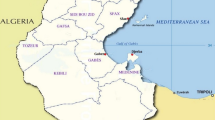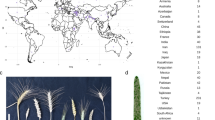Abstract
Efforts to obtain durable resistant cultivars to coffee leaf rust have a long history of disappointment because of the lack of information on the Hemileia vastatrix evolutionary potential. In this study, the AFLP marker was used to analyze the genetic structure of a field population of H. vastatrix from different coffee genotypes cultivated in a wide geographic region of Brazil’s main production areas. A total of 91 isolates were sampled from genotypes of Coffea arabica, C. canephora and Híbrido de Timor/Icatu derivatives. Each isolate exhibited unique multilocus AFLP genotypes with no identical isolates obtained from the same geographical and host origins. This finding was corroborated by a small correlation between genetic similarity and geographic distance (R xy = 0.31, P = 0.23). The analyses showed a low genetic differentiation (G ST = 0.026) between the populations defined by a host and AMOVA analysis, most of the genetic variance (99.56 %) was attributed to differences within populations. In addition, based on the index of association (IA), the random mating possibility was not rejected (IA = 0.225, P = 0.123) for the population of H. vastatrix derived from C. canephora. This result suggested that H. vastatrix in Brazil behaves as a large undifferentiated population with a high level of genotypic diversity that is unstructured with regard to its geographic and host origins.



Similar content being viewed by others
References
Agapow P, Burt A (2001) Indices of multilocus linkage disequilibrium. Molecular Ecology Notes 1:101–102. doi:10.1046/j.1471-8278.2000.00014.x
Bettencourt AJ (1968) Melhoramento visando a resistência do cafeeiro à ferrugem. Bragantia 27:35–68
Bettencourt AJ (1973) Considerações gerais sobre o ‘Híbrido de Timor’. Instituto Agronômico de Campinas, Campinas, Circular n. 23, 20 p.
Bettencourt AJ, Rodrigues CJ (1988) Principles and practice of coffee breeding for resistance to rust and other diseases. In: Clarke RJ, Macrae R (eds) Coffee. Elsevier Applied Science Publishers, London, pp 199–234
Bowden J, Gregory PH, Jonhson CG (1971) Possible wind transport of coffee leaf rust across the Atlantic Ocean. Nature 229:500–501
Cabral PGC, Zambolim EM, Zambolim L, Lelis TP, Capucho AS, Caixeta ET (2009) Identification of a new race of Hemileia vastatrix in Brazil. Australasian Plant Disease Notes 4:129–130. doi:10.1071/DN09052
Cardoso RML (1986) Novas raças de Hemileia vastatrix Berk. et Br. no Brasil, métodos de identificação, e detecção de grupos fisiológicos em cafeeiros derivados do Híbrido de Timor. Dissertation, Universidade Federal de Viçosa, Viçosa
Cardoso RML, Zambolim L, Chaves GM (1988) Ocorrência no Brasil da raça XVI de Hemileia vastatrix Berk. et Br. coletada do germoplasma de Coffea arabica L. no Estado de Minas Gerais. Fitopatologia Brasileia 12:343–346
Carrión G, Rico-Gray V (2002) Mycoparasites on the coffee rust in Mexico. Fungal Diversity 11:49–60
Carvalho CR, Fernandes RC, Carvalho GMAC, Barreto WB, Evans HC (2011) Cryptosexuality and the genetic diversity paradox in coffee rust, Hemileia vastatrix. PLoS One 6(11):e26387. doi:10.1371/journal.pone.0026387
Creste S, Tulmann Neto A, Figueira A (2001) Detection of single sequence repeat polymorphisms in denaturing polyacrylamide sequencing gels by silver staining. Plant Mol Biol Rep 19:299–306
Excoffier L, Smouse PE, Quattro JM (1992) Analysis of molecular variance inferred from metric distances among DNA haplotypes: application to human mitochondrial DNA restriction data. Genetics 131:479–491
Excoffier L, Laval G, Schneider S (2005) Arlequin ver 3.0: An integrated software package for population genetics data analysis. Evol Bioinformatics Online 1:47–50
Fazuoli LC, Oliveira ACB, Braghini MT, Silvarolla MB (2005) Identification and use of sources of durable resistance to coffee leaf rust at IAC. In: Zambolim L, Zambolim EM, Várzea VMP (eds) Durable Resistance to Coffee Leaf Rust. Visconde do Rio Branco, Suprema Gráfica e Editora Ltda, pp 75–115.
Fernandes RC, Evans HC, Barretos RW (2009) Confirmation of the occurence of teliospores of Hemileia vastatrix in Brazil with observations on their mode of germination. Tropical Plant Pathology 34:108–113. doi:10.1590/S1982-56762009000200005
Gouveia MMC, Ribeiro A, Várzea VMP, Rodrigues CJ (2005) Genetic diversity in Hemileia vatatrix based on RAPD markers. Mycologia 97:396–404. doi:10.3852/mycologia.97.2.396
Hamelin RC, Allaire M, Bergeron MJ, Nicole MC, Lecours N (2005) Molecular epidemiology of white pine blister rust: Recombination and spatial distribution. Phytopathology 95:793–799. doi:10.1094/PHYTO-95-0793
Hill MO (1973) Diversity and eveness: A unifying notation and its consequences. Ecology 54:427–432
Hurtado S, Ramstedt M (2002) AFLP comparison of distant Melampsora epitea (willow rust) population. Mycol Res 106:1400–1407. doi:10.1017/S0953756202006846
Kimura M (1983) The neutral theory of molecular evolution. Cambridge University Press, Cambridge
Kushalappa AC (1989) Biology and epidemiology. In: Kushalappa AC, Eskes AB (eds) Coffee rust: Epidemiology, resistance and management. CRC Press, Florida, pp 13–43
Mantel N (1967) The detection of disease clustering and a generalized regression approach. Cancer Res 27:209–220
Martinez JA, Palazzo DA, Karazawa M, Monteiro MVM, Reu NRN (1975) Presença de esporos de Hemileia vastatrix Berk & Br. agente causal da ferrugem do cafeeiro, em diferentes altitudes nas principais áreas cafeeiras dos Estados de São Paulo e Paraná (Brasil). O Biológico 41:77–88
Maynard Smith J, Smith NH, O’Rourke M, Spratt BG (1993) How clonal are bacteria? Proc Natl Acad Sci U S A 90:4384–4388
McCain JW, Hennen JF (1984) Development of the uredinial thallus and sorus in the orange coffee rust fungus, Hemileia vastatrix. Phytopathology 74:714–721
McDonald BA, Linde C (2002) Pathogen population genetics, evolutionary potential, and durable resistance. Annu Rev Phytopathol 40:349–379. doi:10.1146/annurev.phyto.40.120501.101443
Mebrate SA, Dehne HW, Pillen K, Oerke EC (2006) Molecular diversity in Puccinia triticina isolates from Ethiopia and Germany. Journal of Phytopathogy 154:701–710. doi:10.1111/j.1439-0434.2006.01177.x
Monaco LC, Carvalho A (1975) Resistência a “Hemileia vastatrix” no melhoramento do cafeeiro. Ciência e Cultura 27:1070–1081
Nei M (1973) Analysis of gene diversity in subdivision populations. Proc Natl Acad Sci U S A 70:3321–3323
Nei M, Li WH (1979) Mathematical model for studynig genetic variation in terms of restriction endonucleases. Proc Natl Acad Sci U S A 76:5269–5273
Nunes CC, Maffia LA, Mizubuti ESG, Brommonschenkel SH, Silva JC (2009) Genetic diversity of populations of Hemileia vastatrix from organic and convencional coffee plantations in Brazil. Australasian Plant Pathology 38:445–452. doi:10.1071/AP09021
Pei MH, Bayon C, Ruiz C, Tubby I (2007) Population structure of poplar rust Melampsora larici-populina in the UK inferred from AFLP. Plant Pathol 56:472–479. doi:10.1111/j.1365-3059.2007.01570.x
Raeder U, Broda P (1985) Rapid preparation of DNA from filamentous fungi. Lett Appl Microbiol 1:17–20
Ribeiro IJA, Sugimori MH, Moraes SA, Monaco LC (1975) Raças fisiológicas de Hemileia vastatrix Berk. et Br. no Estado de São Paulo. Summa Phytopathologica 1:19–22
Richardson BA, Klopfenstein NB, Zambino PJ, Mcdonald GI, Geils BW, CArris LM (2008) Influence of host resistance on the genetic structure of the white pine blister rust fungus in the Western United States. Phytopathology 98:413–420. doi:10.1094/PHYTO-98-4-0413
Rodrigues CJ, Bettencourt AJ, Rijo L (1975) Races of the pathogen and resistance to coffee rust. Annu Rev Phytopathol 13:49–70
Schieber E (1972) Economic impact of coffee rust in Latin America. Annu Rev Phytopathol 10:491–510
Schieber E, Zentmyer GA (1984) Coffee rust in the Western Hemisphere. Plant Dis 68:89–93
Stoddart JA, Taylor JF (1988) Genotypic diversity: estimation and prediction in samples. Genetics 118:705–711
Vandermeer J, Perfecto I, Liere H (2009) Evidence for hyperparasitism of coffee rust (Hemileia vastatrix) by the entomogenous fungus, Lecanicillium lecanii, through a complex ecological web. Plant Pathol 58:636–641. doi:10.1111/j.1365-3059.2009.02067.x
Várzea VMP, Marques DV (2005) Population variability of Hemileia vastatrix vs. coffee durable resistence. In: Zambolim L, Zambolim EM, Várzea VMP (eds) Durable resistance to coffee leaf rust. Suprema Gráfica e Editora Ltda, Visconde do Rio Branco, pp 53–74
Vishveshwara S, Nag Raj TR (1960) Nuclear status in basidiospores of Hemielia vastatrix B. & Br. Indian Coffee 3:118–119
Vos P, Hogers R, Bleeker M et al (1995) AFLP: a new technique for DNA fingerprinting. Nucleic Acids Res 23:4407–4414
Zambolim L, Chaves GM (1974) Efeito de baixas temperaturas e do binômio temperatura-umidade relativa sobre a viabilidade dos uredosporos de Hemileia vastatrix Berk. et Br. e Uromyces phaseolityca. Arth Experientiae 151–184.
Zambolim L, Vale FXRD, Pereira AA, Chaves GM (1999) Manejo integrado das doenças do cafeeiro. In: Zambolim L (ed) Produção de café com qualidade. Viçosa, Editora UFV, pp 134–215
Zambolim L, Zambolim EM, Vale FXR, Pereira AA, Sakiyama NS, Caixeta ET (2005) Physiological races of Hemileia vastatrix Berk. In: Zambolim L, Zambolim EM, Várzea VMP (eds) Durable resistance to coffee leaf rust. Suprema Gráfica e Editora Ltda, Visconde do Rio Branco, pp 53–74
Acknowledgments
The authors thank the Programa Nacional de Pesquisa e Desenvolvimento de Café (PNP&D/CAFÉ/EMBRAPA CAFÉ), Conselho Nacional de Desenvolvimento Científico e Tecnológico (CNPq), Fundação de Amparo a Pesquisa do Estado de Minas Gerais (FAPEMIG) for financial support.
Author information
Authors and Affiliations
Corresponding author
Rights and permissions
About this article
Cite this article
Maia, T.A., Maciel-Zambolim, E., Caixeta, E.T. et al. The population structure of Hemileia vastatrix in Brazil inferred from AFLP. Australasian Plant Pathol. 42, 533–542 (2013). https://doi.org/10.1007/s13313-013-0213-3
Received:
Accepted:
Published:
Issue Date:
DOI: https://doi.org/10.1007/s13313-013-0213-3




